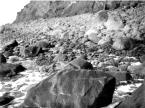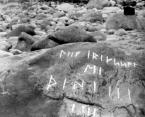It is either the biggest hoax or the most ignored chapter in Island history.
There are people who believe that the mysterious - almost mythic - Viking people once visited, and perhaps even colonized Martha's Vineyard, hundreds of years before Bartholomew Gosnold made land here and named the Island after a family member.
But for every believer in the Viking-Vineyard theories, many more dismiss them as pure poppycock. Over the past 150-plus years, the question of whether Vikings walked the shores of the Vineyard has proven as divisive as it is baffling.
Mystery clues have piled up over the decades like the Da Vinci Code, although most have been dismissed by scholars.
In the past, most of the speculation has centered around a series of mysterious rocks found around the Island, the most famous being the so-called Leif Eriksson runestone discovered on Noman's Land - an uninhabited island about three miles off the southwest corner of the Vineyard - one late afternoon in November of 1926.
The story goes that the Island's owner, Joseph Crane, spotted some strange lettering on a large black rock by the water's edge as the setting sun sank low on the horizon. The strange marks were later photographed in 1927 by a writer, Edward F. Gray, who was researching the Norse voyages to North America for a book.
Mr. Gray noted at the time that the markings were difficult to photograph because the stone was only fully exposed at extreme low tide; and even then, waves broke over it constantly.
The letters, Mr. Gray reported, were about four inches high, and the top two lines were fairly evenly spaced. The lower two were either incomplete or had been partly worn smooth by the action of wind and waves. Mr. Gray was not knowledgeable about runic, the written language of the Norse, but subsequent efforts to decipher the letters concluded that the first two lines read, "Leif Eriksson, MI" (the Roman numeral for 1001).
The lower lines were not deciphered, although a case could be made for the word Vinland as part of them.
Norse legend has it that young Lief Eriksson traveled from Greenland, which his father had settled, to Norway in 999 to the court of King Olaf Tryggvason. The king commissioned Eriksson to bring Christianity to Greenland, but sailing back he was blown off course and - so the legend goes - landed somewhere in North America.
Many of these tales were outlined in Vinland Sagas, the Saga of the Greenlanders and the Saga of Eric the Red, which represent the most complete information historians have about the Norse exploration of the Americas. They were written at least 200 years after the original voyages and some of the accounts are contradictory, but historians believe they contain substantial evidence of Viking exploration of North America.
The Vinland Sagas gained credibility with the discovery and excavation of a Viking settlement at L'Anse aux Meadows in Newfoundland, Canada - although there are still places in the continental United States that have since claimed the honor of being the Vinland described in the Sagas.
Some on the Island have pointed to the description of Vinland in the Sagas - mild winters, self-sown wheat and especially the vines and wild grapes - as evidence that the mythic Vinland was actually Martha's Vineyard.
The discovery of the runestone at Noman's by Mr. Gray fueled speculation that the Vinland of the Sagas was really the Vineyard. Mr. Gray made a name for himself by writing his book Lief Eriksson, Discoverer of America, in which he theorized that the runic rock on Noman's Land was a marker of the famous Vikings visit, or perhaps even the headstone of Leif Eriksson.
It didn't take long for scholars to debunk the theory. A 1935 story in the Gazette reported that Professor Edmund B. Delabarre published in the New England Quarterly a piece concluding that the runic rock was nothing but a hoax.
Dr. Delabarre found it highly unlikely that an engraving could withstand the constant wave action and erosion of the ocean. Several years later, two more scholars questioned the use of the Roman numerals because such enumeration was not used for dating until the 14th or 15th centuries in Scandinavia.
But perhaps the most damning report of the authenticity of the rune stone came on August 31, 1954, when the Gazette reported: "Over the past weekend Capt. Martin Dahl said he saw a Norwegian cook chisel the message into the rock in 1913."
At the time debate over the authenticity of the rock had almost completely subsided, largely because the rock had become submerged during the 1938 hurricane. Searches for the rock halted after World War II when the U.S. Navy started to use Noman's for target bombing.
But an enterprising resident of Old Greenwich, Conn., named Curtiss Bacon - convinced that Capt. Dahl himself was perpetuating a hoax - successfully lobbied the Navy to halt the bombing for one day so that he could lead an expedition to search for the stone.
Mr. Bacon found the stone and promptly disputed Captain Dahl's assertions. In a newspaper story published a week after his expedition, Mr. Bacon said Captain Dahl told him the stone he saw marked by the cook was on the other side of the Island from where the runic rock was located.
Debate over the runestone quieted again until the 1960s when an English newspaper sent an expedition led by J.R.L. Anderson. Mr. Anderson's subsequent 1966 book, Vinland Voyage, focuses more on the details of the expedition than on proving Vikings walked the Vineyard. Although it fails to provide any real proof, Mr. Anderson in his book suggested some of the more fantastic theories to date in the Viking-Vineyard debate.
The author theorized that if Lief Eriksson had followed a logical course of exploration - aided by trade winds and sea currents - there was a good chance he would wind up on Martha's Vineyard. "I cannot say that Lief Eriksson did go ashore on Martha's Vineyard. But after practical experience of our voyage I can say that I think it almost certain that these things happened," Mr. Anderson wrote.
Mr. Anderson also recounts a story in which Leif Eriksson's brother was killed by an Indian arrow, and describes a world of "woods with wild vines - even today, acres and acres of wild vines, a most beautiful feature of the island, and one that would strike anyone with a sense of rich bounty."
From there, Mr. Anderson theorizes that the Vikings may have named the land Vinland because of the vines, a name which may have remained with the native population for centuries. "It is at least possible that when Gosnold got to the Island in 1602 some remnant of an Indian tribe with Norse blood told him as their tongues could get that he had come to Vinland," Mr. Anderson said.
Although the discovery of the runic stone in 1926 is perhaps the most well-documented and most debated evidence of a Viking presence on the Vineyard, it was not the first.
In 1894, Island resident W. Channing Nevin published a poem titled The Norseman and the Vineyard Maid which speculated that Norsemen not only visited Martha's Vineyard at Edgartown but that Leif Eriksson fell in love with an Indian and stayed for several years.
In a Gazette article from 1895, Mr. Channing said he collected historical evidence to back his poem and cited the Vinland sagas as evidence the Vikings settled on the Vineyard around the year 900 A.D. He used information about sunrise and sunset in the sagas to extrapolate longitude and latitude, and concluded the land described in the sagas was, in fact, the Vineyard.
As for the romantic incidents described in his poem, Mr. Channing says that Leif Eriksson, "true to his manly instincts returned to seek his Vineyard maid, only to find that, brokenhearted at his desertion, yielded up her young life with the loved name Norseman on her lips. And so she was buried at Naushon."
There is also the mysterious rock formation found on a hill in Chilmark known as the Cromlech of Quitsa, an oval-topped shelter supported by stone pillars. Some have suggested the rock formation is Norse in origin, although others have dismissed this theory because it is too old to have been built by Vikings.
Other, more sporadic reports of a Viking presence on the Vineyard have surfaced over the past century.
One Gazette report from 1965 reports that Ole Bull, a famous Norwegian violinist, once told friends he saw a Norse inscription on Lover's Rock at the old bathing beach in Oak Bluffs. In his 1969 book, An Introduction to Martha's Vineyard, author Gale Huntington mentions another runic inscription supposedly found near the Old Mill River in North Tisbury. It was traced and studied by scholars, Mr. Huntington wrote, although the stone by that time had been lost.
In the same book, Mr. Huntington also cites the description of the land in the Vinland Sagas as being similar to Martha's Vineyard.
"The abundance of wild grapes and grape vines, the wildlife of the area, and the fish and the whales that were found in abundance. It could have been the Vineyard and perhaps it was the Vineyard . . . why not?" Mr. Huntington wrote.
But this sort of wild speculation raises eyebrows with some Island historians and scholars.
Arthur R. Railton, the author of The History of Martha's Vineyard: How We Got to Where We Are, dismisses all notions that Vikings explored or colonized the Vineyard.
"All those theories have been thoroughly researched and disproven. It seems to be a popular folk tale, but it is more fantasy that fact," Mr. Railton said.
Anthony Horwitz, an Island author writing a book about the first European explorers to North America, also is quick to dismiss theories of Vikings on the Vineyard. The Pulitzer prize-winner attributes much of the speculation to people's fascination with the Norsemen.
"There is something about the Vikings that captures people's imaginations; people think of them as these mysterious and romantic people," Mr. Horwitz said.
He noted that many of the more well-known Viking discoveries have proven to be hoaxes. Mr. Horwitz believes the Vikings never got past New Brunswick, Canada, and agrees with a vast majority of scholars that the only Norse settlement in North America was at L'Anse aux Meadows in Newfoundland, Canada.
"It's the only place where actual, undeniable proof has been discovered of a Viking presence. Most other so-called Vikings markings have been found to be glacial scratches or scratches from tools," Mr. Horwitz said, adding:
"I think why some of these hoaxes have held up as true for a few years is that people want to believe them."But when asked if a Viking visit to the Vineyard was completely impossible, Mr. Horwitz was reluctant to shut the door entirely.
"Is it possible [the Vikings] came to the Vineyard? The short answer would be yes . . . it is possible. They were amazing seafarers and adept explorers, so you can't completely dismiss it as impossible. I myself am no scholar, but again the scholarly consensus is that it didn't happen, and I would tend to agree," he said, adding:
"But you never know - anything is possible."






Comments
Comment policy »